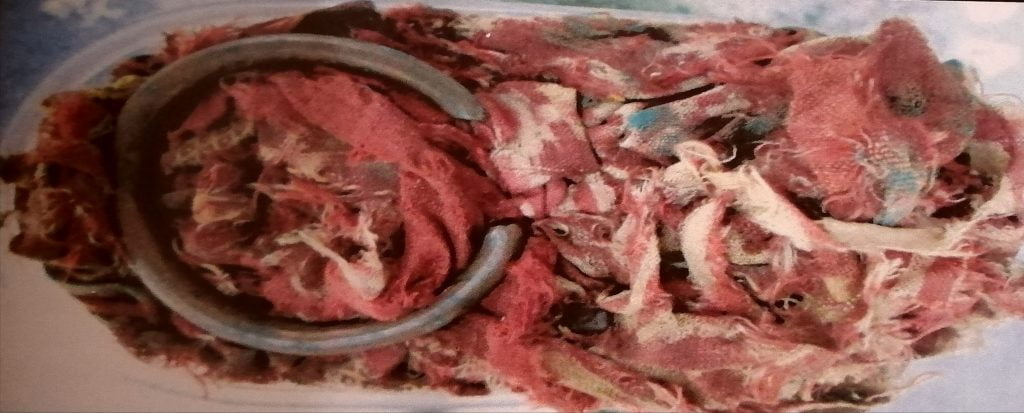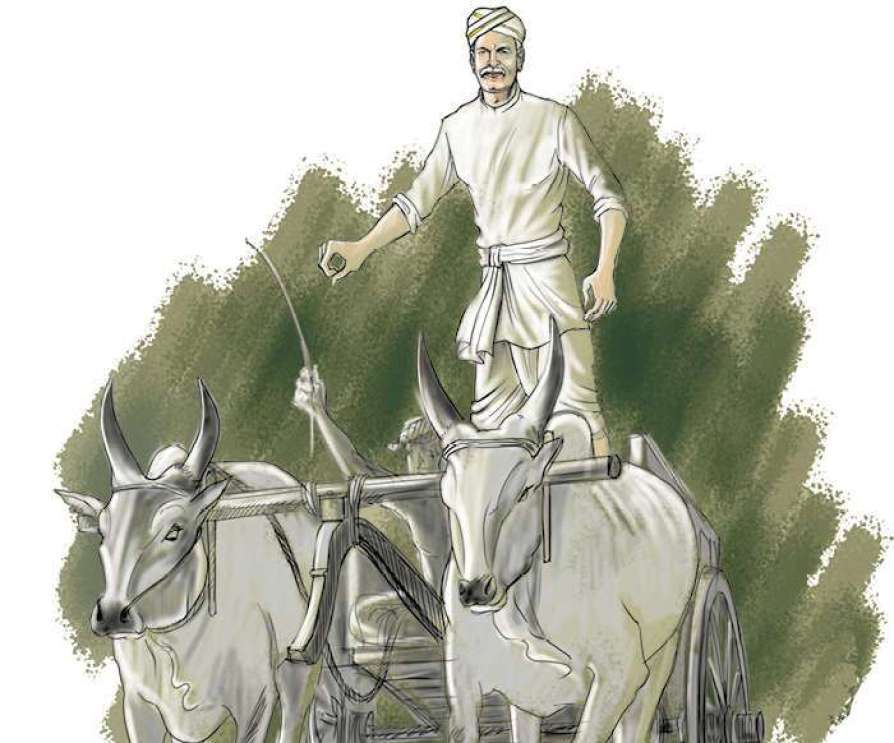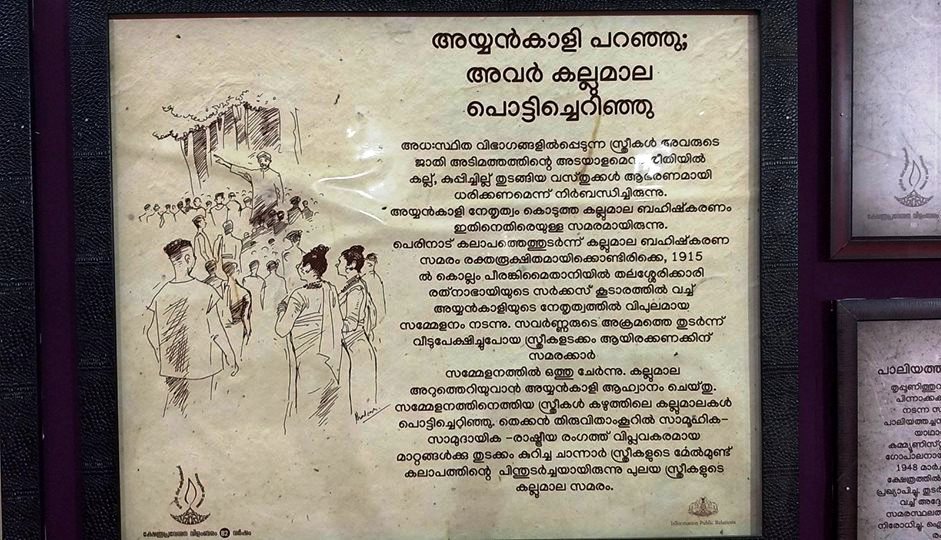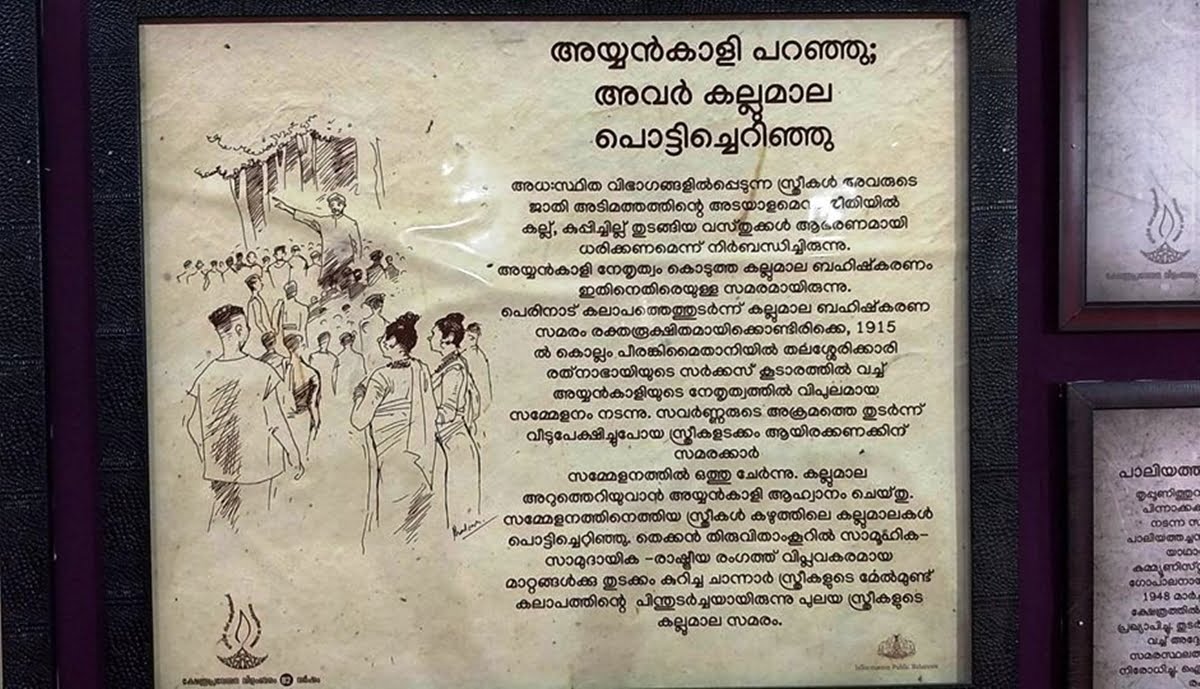Among the many caste oppressions and disenfranchisements imposed on the dalit and bahujan communities in Kerala in the past, there have been severe restrictions on sartorial choices. Kallumala Samaram, that took place in December 1915, was a significant event that overturned that. Elaborate codes of attire: on what certain castes could wear or were prohibited from wearing were part of the everyday activity embodying and entrenching the practice of caste while also informing the notions of respectability, morality and graded hierarchy. Caste oppression took many shapes and forms, regulating everyday practices to the extent of them being normalised by the society. There were not only strict prohibitions on lower castes wearing stitched garments, they were only permitted to wear clothes which were knee-length.
Dalit women in particular were prohibited from covering their breasts or wearing an upper-body cloth. They were made to wear necklaces made of stones or glass to mark their lower caste status. This was what they finally disowned in the historic Kallumala Samaram.
Dalit women in particular were prohibited from covering their breasts or wearing an upper-body cloth. They were made to wear necklaces made of stones or glass to mark their lower caste status. This was what they finally disowned in the historic Kallumala Samaram. The ‘untouchable’ castes were also not allowed to wear ornaments made of gold or silver and could only wear ornaments of iron or stone while the middle castes could wear ornaments of bronze or brass.
Also read: ‘Pele Colour’: How Casteism & Colourism Dictate Sartorial Choices
The state which systematically extracted corvee labour (labour without any remuneration) from the dalits was in compliance with the perpetuation of caste norms and any transgressions were duly punished. The Cochin royal records and the Matilakam records have lists of utensils and clothes being gifted to people belonging to different communities for services rendered or as alms according to their caste positions.
Even in the case of the famed Ezhava (a mid-level caste counted as OBC now) physician, Itti Achuden, who was part of the production of the monumental work Hortus Malabaricus as part of the panel of experts instituted by the Maharajah of Kochi; it was an iron bangle and a silk garment which were given to him as part of the royal tradition of gifting pattum valayum by the king, instead of the gold bangle and silk cloth which were the usual gifts.

The sartorial codes were imposed more often through upper caste mob-violence than state intervention. With the arrival of the Christian missionaries and the consequent spread of the notions of Victorian morality, the use of blouse/roukas/jacket became popular in Travancore albeit in a limited manner. Christian Shanar/Chanar women started covering their upper bodies which prompted their Hindu counterparts to follow suit and this led to the unleashing of violence by upper castes against them. The Shanar/Chanar rebellion (1813-1859) was a direct consequence of the upper caste Nairs and Namboothiris trying to maintain and reinforce the caste status-quo. The CBSE had very slyly removed a chapter on textile history which included a section on the Chanar revolt in 2017.
Quite often, in formal and informal discourse on the discriminatory sartorial practices in Travancore, the upper caste rhetoric is to point to upper caste women of the Nair and Namboothiri caste who also did not cover their upper torsos. The Dutch memoirs on Malabar such as those by Adriaan Moens mention the Cochin and Travancore royal queen mothers not wearing any upper garments. However, the effective difference between the experience of upper caste women and lower caste women which does not get enough attention is the question of choice. While there were several restrictions on upper caste women, particularly of the Namboothiri caste which squarely restricted their mobility such as the use of the marakuda (a palm leaf umbrella used to cover themselves lest they be seen by those belonging to castes lower than theirs); what is to remembered is that the premise of the discrimination is still one of unapproachability borne by the lower castes.
The impact of sartorial politics in subjugating and controlling women have been discussed in the context of Europe of how European women marshalled attire and dressing etiquette to display social status, dynastic rank and evoke a sense of loyalty to particular groups. It was also to maintain gender and social hierarchies in the moral economies of Early modern Europe.
Pierre Bourdieu has theorised about the deep impact of embodied practices in constructing and enforcing codes of discipline and control. Bourdieu, in his classic work Distinction, argues that the notion that it is the working of a ‘habitus’ which makes one dispositioned to certain preferences and tastes is in reality deeply culturally ingrained by a priori structures of power and social rank so much so that it seems ‘natural’. The habitus extends to language (dialect, vocabulary and accent), food, and clothing and I would argue, also to ideas of ‘social etiquette’ or what is referred to as ‘good manners’ in the Indian context. The habitus also works as a structuring device and signifier of both class and caste.
Sartorial politics, particularly ones which restrict and enforce particular codes of attire such as strict prohibitions against wearing the melmundu (upper body garment), must be read as being crucial to the creation of a caste habitus. It was indeed this caste habitus that social reformers such as Mahatma Ayyankali, Sree Narayana Guru and Poikayil Appachan were challenging. Often, it is reductively thought that the work of the social reformers was to uplift the specific communities that they belonged to, but their role was to reform and realign the patterns of hierarchical habitus.

Ayyankali, who himself openly challenged caste laws by wearing a coat and a mundu and using a villuvandi (which only the upper castes were permitted to use) responded to the movement which was started by Pulaya women at Perinad demanding the right to cover their breasts in October 1915. The upper caste men had attacked the gathering of Dalits and this had led to a riot-like condition in Perinad. A gathering of pulaya, paraya and other dalit women were organised by Ayyankali at Kollam in a circus tent owned by a dalit woman, Ramabai on 21 December 1915. At the event, hundreds of pulaya and paraya women cast off their stone necklaces which was a marker of their lower caste status in a symbolic and literal act of defying the caste system. This event came to be known as the Kallumala Samaram and marked a historic event in the history of anti-caste struggles in South India. The gathering also witnessed caste violence by upper caste men which subsequently led to a court case being registered, which the dalits won.
In December 1915, hundreds of pulaya and paraya women cast off their stone necklaces which was a marker of their lower caste status in a symbolic and literal act of defying the caste system. This event came to be known as the Kallumala Samaram and marked a historic event in the history of anti-caste struggles in South India.

Also read: The Channar Revolt: The Fight For A Dignified Existence
K S Madhavan, prominent historian from Kerala argues that “mainstream history, in which dalits are treated as passive subjects, has led to an organised move for the dehistoricisation of dalit life and experiences.” The historian’s words ring true if we consider the near absence of professional history writing on the historic anti-caste struggles by the dalits in South India other than that of the brilliant exception of works by Professor Sanal Mohan and K S Madhavan. The lack of any public celebration in commemoration of the event or even mentions of the Kallumala Samaram, also known as the Perinad Mutiny, in major newspapers in the month of December leaves a poignant void that only becomes larger against the light of the caste-based honour killing that the state of Kerala had witnessed in December 2020.
Featured Image Source: Advaidism/Twitter





Thank you for the article. Ayyankali was indeed a pioneer in Kerala and the act of breaking of Kallumala was symbolic resistance. It was a statement that lower castes won’t be subservient to the powerful upper castes. The women who participated in this were molested and maimed but they didn’t give up. It is all because of people like Ayyankali that Kerala is a better place to live compared to the last century. We should not forget our history